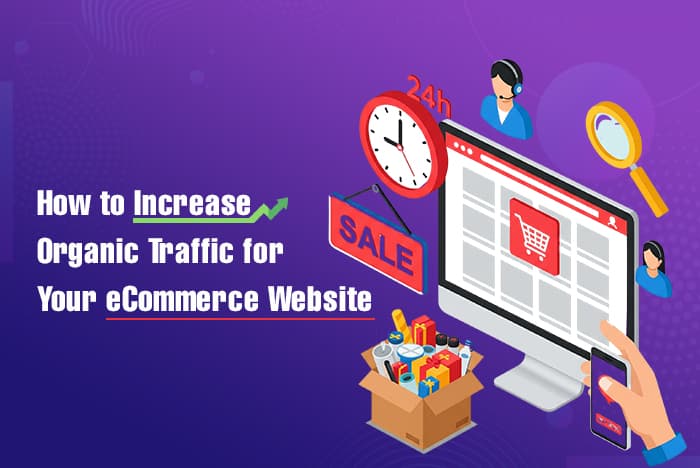Proven Strategies to Increase Organic Traffic to Your eCommerce Store

In the world of the incredibly competitive online retail, a beautiful site is just a half of the battle. Without people being able to find you they are unable to buy your product. That is when an effective SEO strategy will turn to be your most precious asset As opposed to paid advertising, the flow of traffic stops as soon as your budget is depleted, whereas a properly planned SEO generates traffic on a sustainable, long-term basis.
When you manage to optimize your online store and reach high positions in search engine results, you also get motivated buyers who will actively seek the products similar to yours. Partnering with a professional eCommerce web design company India can further strengthen your strategy by ensuring your site is not only visually appealing but also SEO-friendly. This ultimate guide will take you through the six most crucial steps in an eCommerce SEO service plan to help you convert organic traffic into sales to optimize your online business operation as a sales powerhouse.
1. The Heart: Keyword Research in the eCommerce
The first step to increasing organic traffic is by learning to understand what they are interested in searching. Keywords research is the solid foundation of any SEO strategy. It will assist you in tracking the words and phrases that your potential customers resort to when searching products like yours.
Classify Keywords by intent: Not every search is the same. An effective strategy can focus on various kinds of keywords.
Informational Keywords: Keywords that a user will enter as part of the informational research of a subject (e.g. what are the best marathon training runners?). These are fantastic as blog posts.
Navigational Keywords: Consumers who know what exactly they want to consume searching a brand or a product name (eg. Nike Air Max 90).
Transactional Keywords: Words and phrases that tell you a person is willing to make the purchase (e.g., buy Adidas running shoes online, discount on protein powder). This is what needs to be on the forefront of your product and category pages.
Research Tools: Use business tools such as SEMrush, Ahrefs, or Moz to locate keywords, analyze their volume, and test their difficulty. Free versions such as Google Keyword Planner can also serve as a good starting point.
Target Long-Tail Keywords: These are more descriptive, longer phrases (for example, "women's waterproof hiking boots for sale"). They have a lower volume but a significantly higher conversion rate because they represent a user's precise intent.
2. On-Page SEO for Your Online Store
On-page SEO is the process of optimizing individual web pages to rank better and acquire more relevant traffic in search engines.
Product Page Optimization: Each product page is a potential landing page.
Unique Product Descriptions: Do not copy and paste from the manufacturer. Create unique, detailed, and keyword-rich descriptions that point out benefits and answer possible customer questions. This avoids duplicate content penalties and assists you in ranking.
Descriptive Title Tags & Meta Descriptions: Your title tag is the search results clickable headline. Put your main keyword, product name, and brand in it. The meta description is a short summary; make it a strong call to action to increase your click-through rate.
Image Optimization: Compress product images to load more quickly without sacrificing quality. Utilize descriptive file names and alt text to inform search engines of the image content (example: men-running-shoe-blue.jpg and alt="Blue running shoe for men").
Category Page Optimization: Category pages are most important for targeting general keywords.
Unique Content: Create a unique, keyword-rich description for every category page.
Internal Linking: Link from category pages to your individual product pages. This enhances navigation and facilitates search engines to discover all your products.
3. Technical SEO: Having a Healthy Website
Technical SEO sees to it that search engines are able to crawl, index, and comprehend your website. This is an area where a savvy ecommerce website design firm can be a valuable partner.
Site Speed: A slow website is one of the biggest causes of high bounce rates and low rankings.
Optimize Images: Resize and compress all images.
Leverage Caching: Use browser and server caching to speed up return visitor loads.
Select a Fast Host: Ensure that your hosting company is stable for consistent performance.
Mobile-Friendliness: As most of your traffic will be from mobile devices, your website should be responsive and offer an optimal mobile user experience. A mobile-friendly website is a prerequisite to search rankings.
Structured Data (Schema Markup): This is code you implement on your site to assist search engines in understanding your content more clearly. For e-commerce, this includes:
Product Schema: To show product information such as price, availability in stock, and reviews inside search results (rich snippets).
Review Schema: To display star ratings, which help tremendously with click-through rates.
Sitemaps & Crawlability: Submit and create an XML sitemap to the Google Search Console. Periodically check your site for broken links (404 errors) and repair them to enhance crawlability.
Also Read: What Is eCommerce? Definition, Types, Advantages, and Disadvantages
4. Off-Page SEO & Link Building
Off-page SEO involves actions taken outside of your website to impact your rankings. The most important factor is link building.
Quality over Quantity: Focus on acquiring high-quality backlinks from reputable websites in your industry. A link from a trusted source is far more valuable than dozens of low-quality links.
Link Building Strategies:
Guest Blogging: Write high-quality content for other blogs and include a link back to your store.
Influencer Marketing: Get influencers to review your products, which will drive natural backlinks and brand visibility.
Broken Link Building: Identify broken links on other sites in your niche and offer your product page or related blog post as an alternative.
Partnerships: Partner with complementary companies to market each other's products and link to each other's sites.
5. Content Marketing & Blogging
Content marketing is a strong long-term tactic for drawing new organic traffic. By producing relevant content, you are drawing in visitors who are in the research stage of their buying cycle.
Begin a Blog: Establish a blog with posts that answer frequently asked questions or resolve issues for your target market. For instance, a home decor store could publish "5 Tips for Creating a Cozy Living Room."
Create Guides and Tutorials: Create detailed guides, "how-to" blog posts, or video tutorials showcasing the application of your products. This establishes your company as a useful authority.
Use User-Generated Content: Ask customers to leave reviews, testimonials, and post photos or videos of your products. Such content is an effective source of social proof and excellent for SEO.
6. Local SEO (For Physical Locations)
If your business has physical locations, local SEO is essential for driving both organic online traffic and foot traffic.
Google Business Profile: Create and optimize your Google Business Profile (formerly Google My Business). This helps your store appear in local search results and on Google Maps.
Local Citations: Ensure your business name, address, and phone number (NAP) are consistent across all online directories (e.g., Yelp, Yellow Pages).
Encourage Reviews: Eagerly invite customers to leave reviews on your Google Business Profile and other local listings.
7. The Final Piece: Analytics & Optimization
An effective SEO plan is an ongoing process of analysis and optimization.
Utilize Google Analytics and Search Console: These are free tools which are vital for tracking your website's performance. Monitor organic traffic, keyword positions, and user behavior.
Monitor Competitors: Analyze your competitors' keywords, backlinks, and content strategy using tools.
Iterate and Improve: Refine your strategy based on your data. Refresh old content, optimize new pages, and invest even more in what's working. A good eCommerce website design company India offers these services under one comprehensive SEO package.
Conclusion
Growing organic traffic on your e-commerce website demands a strategic, multi-faceted approach. It's about establishing a solid foundation through focused keyword research, optimizing each page for search engines and users alike, and making sure your site is technically sound. By keeping these fundamentals top of mind and continually tracking your progress, you can make your online store an authority within your niche. While it can be overwhelming, having a skilled team to work with can offer the know-how to deploy a solid SEO campaign that generates organic traffic and makes visitors into lifelong customers, ensuring your company's long-term prosperity.
Also Read: 10 Qualities of a Good eCommerce Website Design
Recent Blogs

14 Must-Have Features For Ecommerce Websites

How to Choose a Domain Name for eCommerce Website
